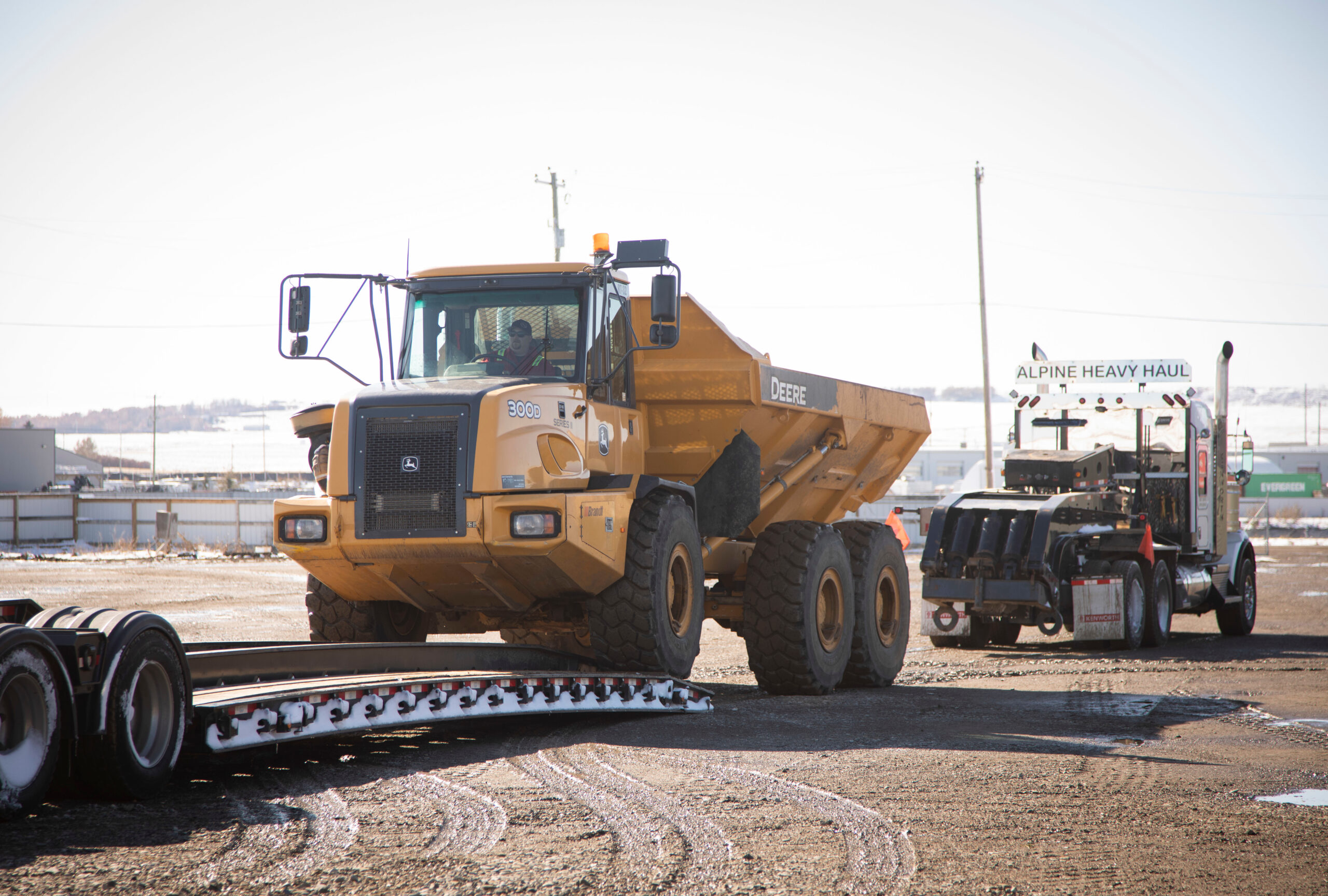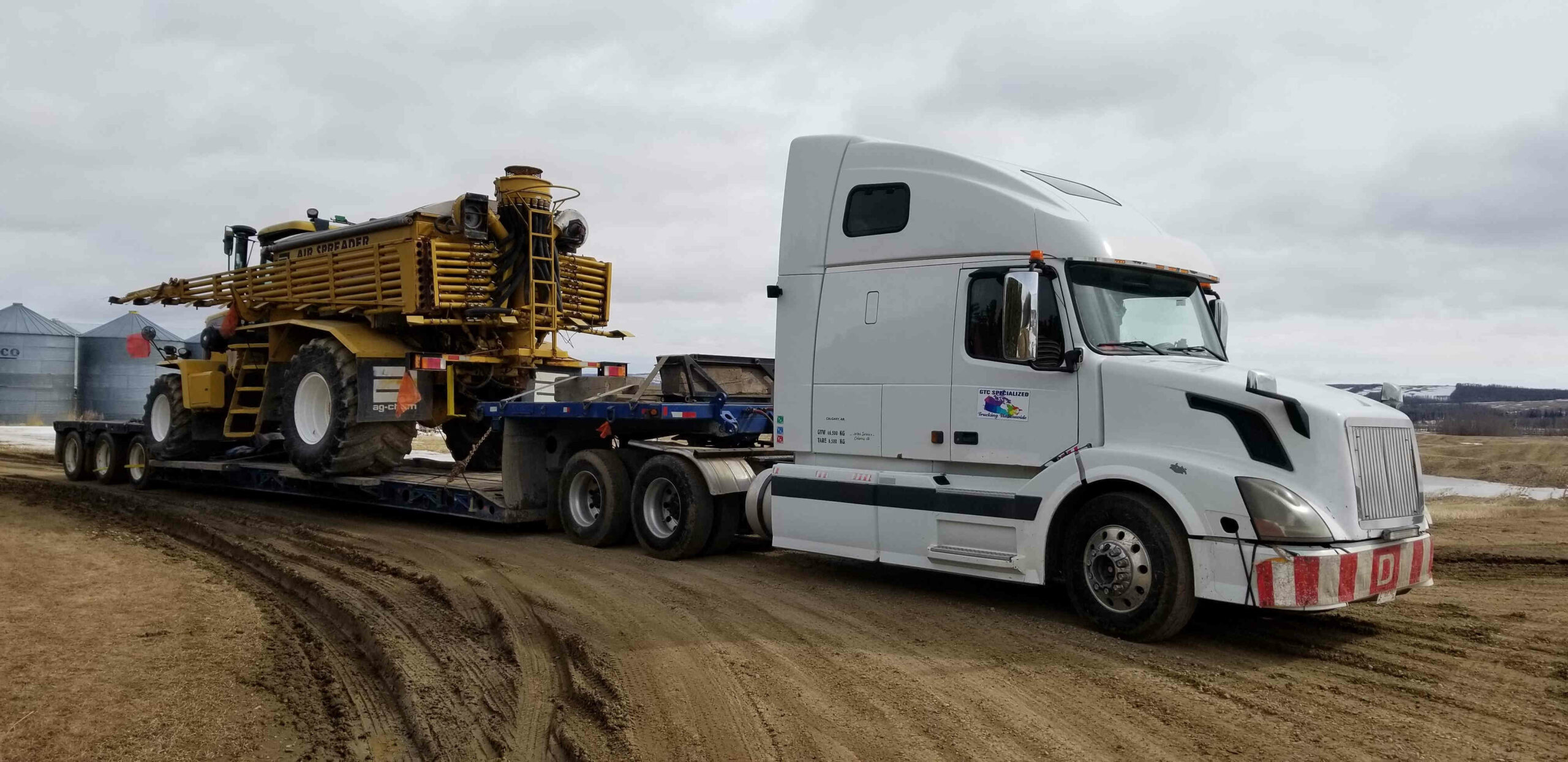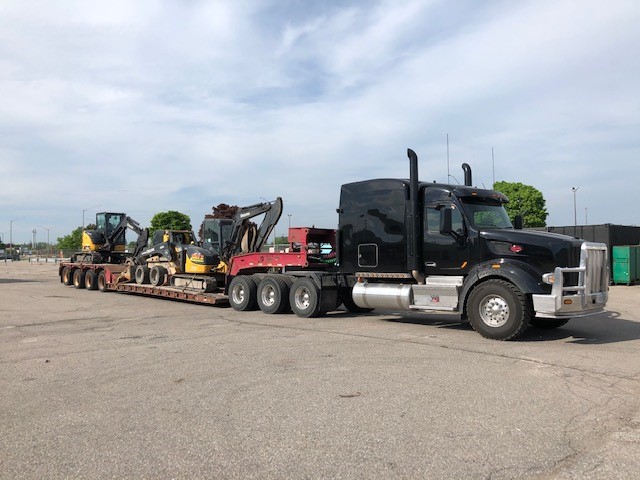Every safe heavy haul begins with a safe load. Even the most experienced drivers will take their time assessing the space and machine that requires loading before driving it onto their trailer or aligning their truck up for a crane or forklift. The main takeaway is that loading anything heavy onto a truck requires safety to be a priority. When you use a load board or hire an independent driver, it’s up to you and that driver to create a loading plan for your shipment.
Our customers know they need to be available and have a plan in place for pick-up day. In some cases, drivers may have the resources when you don’t, but you should always ask them before assuming anything. If you’re new to heavy hauling, here are some basic loading tips you need to know before shipping any heavy equipment.
Loading 101 for Heavy Equipment Loads
While there are different methods for loading heavy objects onto a truck’s flatbed, there are several basic rules that apply no matter what method you are using. Here are the 101 tips for loading large machinery.
Communicate Dimensions Before Pick-Up Day
To use the Trusted Dispatch platform and get your free, instant quote, you must first tell us the dimensions, weight, and destinations. Without that information, we cannot pair you with a driver going in the right direction. Knowing the size of the load is also essential to finding a driver with the right equipment.
If you’re not working with us, you’ll need to tell your driver what they can expect ahead of time so they arrive with the right tools and axles on their trailer. Communicating these details can ensure your shipment is on time.
Choose Level Ground
On loading day, you’ll want to select level ground to park the truck and trailer to load your shipment onto the deck. Level ground reduces the risk of tipping your machine or even the trailer. You may need to prepare the ground ahead of time to make it level or as close as possible. For example, if you’re moving equipment after a snowfall, you’ll want to plough your loading zone before the truck arrives.
Leave Plenty of Room
Large, heavy equipment requires a large trailer and semi-truck to pull it. This vehicle needs room to maneuver and park a trailer without tipping, getting stuck, or bumping into things. Choosing a loading area with lots of room to maneuver the trailer, truck, and any load assist equipment is best.
Clear Away Obstacles
You’ll not only want an area to load up in that is wide open, but you’ll want to clear the area of any debris, vehicles, machinery, people and animals. Plan ahead of time to move any equipment, supplies or vehicles that are usually in the area. Keep animals tied up or inside when possible while loading happens.
Don’t Load Alone
While it may be possible for one person to load equipment, it’s best practice for safety and efficiency to have at least two people on-site to help with loading. Even seasoned professionals will appreciate having an extra set of eyes spotting them while loading your equipment.
Plan Ahead
We’ve said this many times, but it bears repeating. Planning ahead for loading day will help you avoid unnecessary headaches on the day. Not to mention you’ll also make your driver’s job easier. Most delayed starts to shipping are the result of poor planning and preparation.
With Trusted Dispatch, you can contact your driver directly through our secure app, allowing you to make a plan and coordinate expectations with your driver before pick-up day. No surprises lead to faster, smoother shipments.
Be Prepared
We’re about to get into detail on how exactly you can load a heavy piece of equipment onto a trailer by discussing four different methods. If the method you need to use involves ramps, consult with your driver as to whether they have them or if they’re built into the trailer. Lowboy trailers often have beavertail ramps built in—these are ramps that fold down when loading and unloading and fold up vertically while driving. If not, you’ll need to secure ramps strong enough to support the weight while loading.
Four Methods of Loading Heavy Machinery and Equipment
Method #1 – Roll On/Off
When your heavy load is on wheels or tracks, it is easier to load onto the trailer. This type of loading is called the roll-on/roll-off method because you can drive the machine or vehicle directly onto the trailer for transport. In order for this method to work, someone will need to be available with keys to the machine, and the machine will need to have enough fuel to drive on and off the truck during pick-up and drop-off.
While driving onto a trailer is the most straightforward loading technique, it does require careful precision. Where you park your machine on the trailer also matters. Parking too far forward or back can put stress on the truck and throw the load off balance. Therefore it’s important to park the machine in an optimal position for the trailer.
Method #2 – Using a Forklift
Some heavy pieces of machinery are not on wheels meaning you cannot drive them onto the trailer. In these cases, a forklift is a helpful tool to lift and load items onto the trailer. Put the ramps in place and drive the forklift onto the trailer, placing the machine or load into the right position. When you need to use a forklift to load, you’ll also need to arrange for a forklift on the other end—unless you can send your forklift along for the trip or your driver has access to a forklift, they can take on the shipment.
Method #3 – Use a Trailer Crane
Some specialized trailers have a built-in crane to rotate and lift heavy items from the ground and onto the trailer. This is useful when you can’t drive your cargo onto a trailer or have access to a forklift. This type of trailer is not standard, so you may not always be able to find a driver with a trailer crane during the window of time that you need your cargo shipped.
Method #4 – Use a Crane
An independent crane is necessary for large loads that cannot drive onto the trailer and require more height or power than a built-in trailer crane. If you’re a regular shipper of large machinery, equipment, or supplies, you may have a crane on-site to assist with the loading. If you’re an independent customer who needs to move something oversized that requires a crane, you’ll need to arrange for load assist on the pick-up day. It’s always a good idea to inform your driver so they know what to expect when they come to get your shipment.
How Do You Decide Which Loading Method to Use?
The drivers in our network are experienced, heavy-hauling professionals. If you have questions or feel unsure about how to load your equipment onto a truck, you can ask your driver for advice or get in touch with us. We’ll ask the right questions to know what you’re dealing with and help you find the right solution. Even if we don’t have the answer immediately, we’ll call our experts for advice and get back to you as soon as possible.
Heavy hauling is a serious business, and it’s always better to ask questions ahead of time than to risk assumptions.
Some Common Mistakes to Avoid
Not everyone who hauls heavy equipment takes the time to prepare before loading day. One quick search on YouTube will turn up heavy hauling mistakes that you can easily avoid with the proper precautions. Here are a few mistakes that are too frequently the cause of most mishaps.
Mistake #1: Not Choosing the Right Trailer for the Load
As we mentioned at the start, knowing the size and weight of your shipment is essential to choosing the right size trailer. Your driver also needs to know how much your shipment weighs. Governments have strict rules about maximum weights on public roadways. These limitations are there to protect the integrity of the roads themselves and to keep drivers safe when crossing infrastructure such as overpasses and bridges—which can only hold a certain measure of weight.
Weight limitations are not just for the roads but for the trailer used to haul the equipment. Each wheel and each axle has a maximum weight it can safely carry, and that falls within the road regulations. Knowing your load dimensions in advance ensures that your driver arrives on pick-up day with the right trailer and number of axles in place.
Mistake #2: Loading in the Wrong Position
Positioning a piece of heavy machinery, such as a backhoe, excavator, or combine, requires precision. Whoever is in charge of driving the machine onto the trailer will need to drive steadily, in a straight line, to avoid falling off the trailer or tipping the machine in the process. This is why having more than one person on-site during the loading and unloading process can help avoid accidents.
Once on the trailer, it’s important to park the machine in just the right spot. Loading it too far forward on the trailer can put too much weight on the truck and cause damage. Loading too far back on the trailer can cause your trailer to fishtail while driving. A fishtailing trailer is highly dangerous and can lead to it, the load, and the truck flipping on the road. Knowing the safest position to park the machine requires experience and training.
Mistake #3: Not Securing the Load Properly
As you may have already guessed, heavy loads also require strategic securement. The placement of tie-down points on a piece of machinery is not assigned randomly. There is a science where you need to tie down a machine to prevent it from shifting during the trip. The more the machine weighs, the heavier the chain that you’re required to secure it with. You’ll also need to use more tie-down points to secure the additional weight.
Throwing a chain over a load and hooking it to the trailer is not enough to prevent movement. All heavy hauls require a ratchet system to ensure the load can’t fly off or shift on the trailer, causing the problems we just outlined in mistake #2. Failing to secure a load properly can result in fines if the driver fails an inspection. Worst of all, improper load securement can lead to accidents, put the public at risk, and can result in damage to your valuable equipment.
Mistake #4: Not Cleaning the Trailer
This mistake may seem minor, but not cleaning off the trailer before loading the machine can be hazardous. For starters, a clean trailer makes it easier to drive equipment onto it. A clean trailer also makes it easier to secure the load without grime or mud getting in the way. Another consideration is that if your trailer has pebbles or small stones on it before pulling out onto the highway, there is a chance one of those stones could fly off at any point and cause damage to surrounding traffic. You or your driver may never know the damage your dirty trailer has caused, which is why it’s best practice to ensure it’s clean of loose debris.
Hire Professional Heavy Haulers
If you’re looking for straightforward heavy-haul shipping and peace of mind throughout the process, hire a professional heavy hauler. Professionals know how to load heavy equipment for transport that follows the provincial or dot regulations and keeps your load and the equipment safe. Getting your heavy-duty shipment to its final destination in one piece is the priority of experienced drivers every time.
Your Heavy Equipment Hauling Experts in Canada and the United States
Get started with safe heavy hauling today with a free, instant quote on the Trusted Dispatch load board. Simply enter the dimensions, weight, pick-up location, and drop-off destination to receive your quote and get matched with an available driver today.




